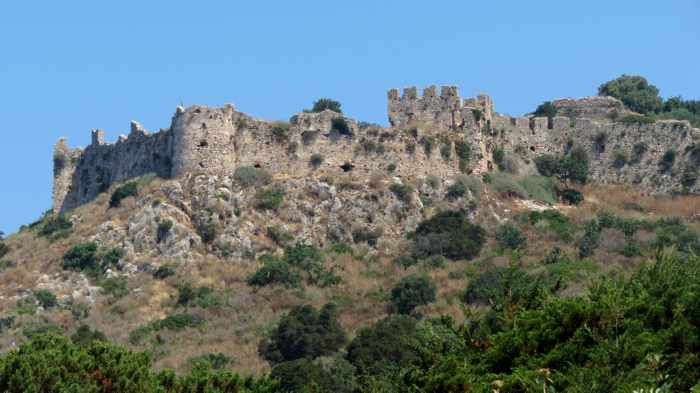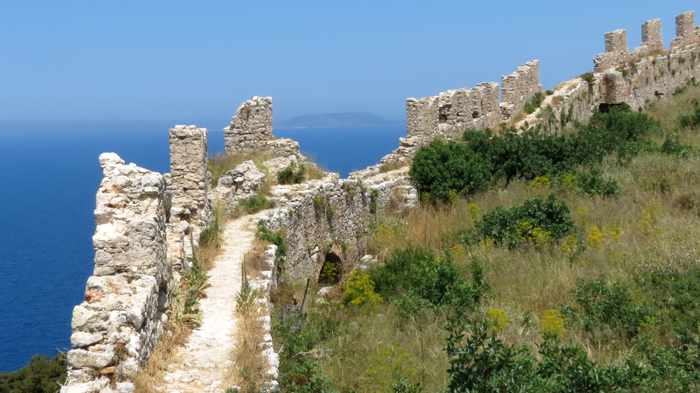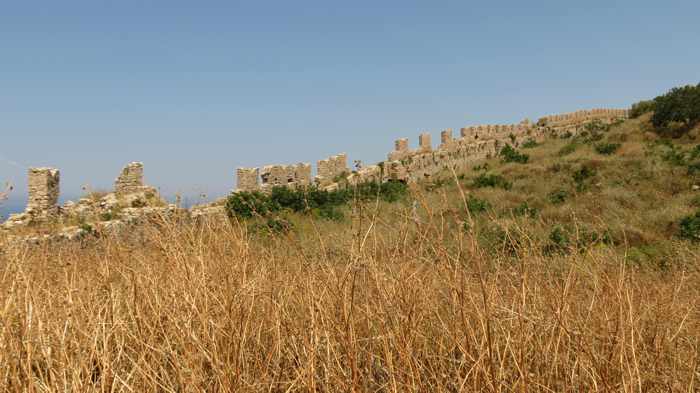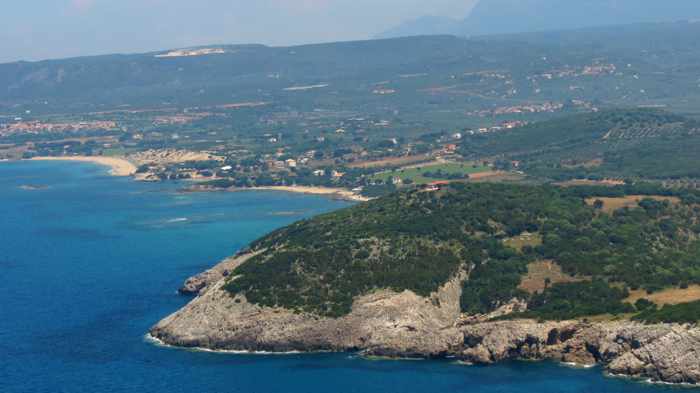
Walls on the southern side of Palaiokastro, the Old Castle of Navarino, which was built in 1278 near the town of Pylos in the Peloponnese

Though parts of the castle walls have collapsed, you can walk atop some of the remaining sections, such as this one high above the Ionian Sea

Walking inside the walls can be difficult — even perilous in places — if you stray off the main trail or try to take a shortcut from the west wall to the east, as we did. The castle’s south yard is overgrown with shrubs and prickly bushes, and the ground is covered with loose rocks and stones that wobble and roll underfoot.

The big payoff for those people who make it all the way up to the northeastern corner of the castle: The incredible views of the Ionian Sea, Navarino Bay and the beautiful Messenian coast …

… and, most impressive of all, the stunning Voidokilia beach
Scenic trek: Built 740 years ago, the Palaiokastro / Old Castle of Navarino is certainly showing its age.
Its hilltop exposure to the elements, plus hundreds of years of neglect, have taken a severe toll. The outer walls are crumbling — some sections have collapsed, while others appear ready to tumble anytime — and only ruins remain of the buildings that once stood inside. Those structures have been reduced to rubble; the former walls and foundations are now boulders, stones and rocks scattered across the ground. The two castle yards are almost entirely overgrown with shrubs, prickly plants, tall grasses and trees that obscure most of the fortress’s interior. It’s possible to walk on some of the outer walls, and dirt paths wind through parts of the grounds, but it can be dangerous to step off the main trails — the rocks underfoot tend to shift and wobble as you walk over them, so there’s a constant risk of slipping and falling or twisting an ankle.
Because of the ancient castle’s derelict condition, plus the ever-present possibility of loose stonework falling from its weathered walls, the Palaiokastro is supposed to be out of bounds to visitors. There’s no fencing to keep anyone out, and no security guards to stop people from entering — just a solitary sign warning that “The Castle of Navarino is closed due to serious danger.” But that doesn’t deter thousands of tourists from visiting the site every year.
For most, it’s the breathtaking “must see” views that attract them — especially the castle’s unrivalled vantage points for photographing the incomparable and immensely Instagrammable Voidokilia beach.
That’s the main reason why I climbed up to Palaiokastro during our trip through the Peloponnese in May 2017 — I wanted to experience, in-person, the outstanding Voidokilia beach views that had fascinated me in many travel photographs and videos I had seen over the years.
To be honest, I didn’t know the castle was closed, and I also didn’t see the “danger” sign at the bottom of the access path. (My hiking companions did, but they never mentioned it.) I had read about Palaiokastro on a few travel websites, and knew that it consists mainly of defensive walls enclosing crumbled ruins, but none of the articles had said anything about the castle being closed or possibly dangerous to visit. Some sites even described it as a not-to-be-missed historical attraction. I figured it would take some effort to reach, since it’s situated atop a craggy hill a few hundred meters high. But once up top, I expected that it would be relatively easy to walk around, like the marvellous Methoni Castle which we had visited just the day before (see my post: A walkabout in Messenia’s 800-year-old Methoni Castle for an account of that.) So when we found the castle access path at the northwest end of Divari beach, I was eager to head up for a look around.
To continue reading and to see more photos of Palaiokastro, please click on the link under the video below to turn to page 2.
This video by AllMessinia takes you on a short flight above Palaiokastro, while subtitles provide historical information about the monument
CONTINUED ON PAGE 2






0 Comments
2 Pingbacks